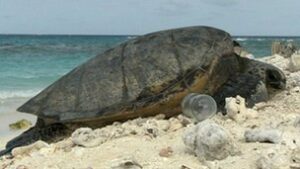In 2020, when the BBC’s Natural History Unit visited an island northwest of Hawaii, they observed how discarded plastic ends up thousands of miles away. While they were filming, they saw turtles nesting between plastic waste. They also saw dead and dying albatross chicks, accidentally killed by their parents who fed them plastic. Some chicks died because of sharp edges punctures, others from starvation because they thought they were full due to stomach being filled with plastic they can’t digest.
Some plastic waste in the oceans is illegally tipped or is litter from fishing. But most of the waste comes from the land, from badly governed landfill sites, and industrial waste.
How plastic affects the Sea life
 The effect of plastic waste on sea life is significant and, quite frankly, horrible. Every year, up to a million seabirds die because of plastic waste in our waters. Studies estimated that around 50% of turtles have ingested plastic. Even if they eat 14 pieces of plastic, they already have an increased risk of death. The young ones are even more at risk because they are not so picky as their parents yet as to what they eat. On some beaches, turtles’ reproduction rates dropped because there was so much waste, which causes the sand temperature – where incubation happens – to change. Scientists think that 60% of all seabird species have eaten plastic pieces. They predict this figure to rise to 99% by 2050.
The effect of plastic waste on sea life is significant and, quite frankly, horrible. Every year, up to a million seabirds die because of plastic waste in our waters. Studies estimated that around 50% of turtles have ingested plastic. Even if they eat 14 pieces of plastic, they already have an increased risk of death. The young ones are even more at risk because they are not so picky as their parents yet as to what they eat. On some beaches, turtles’ reproduction rates dropped because there was so much waste, which causes the sand temperature – where incubation happens – to change. Scientists think that 60% of all seabird species have eaten plastic pieces. They predict this figure to rise to 99% by 2050.
Even though dolphins are highly intelligent and therefore unlikely to eat plastic waste, they are still receptive to plastic if the prey they eat ingested synthetic compounds.
Plastic waste also increases the growth of the pathogen in the waters. Scientists discovered that corals that come into contact with plastic have an 89% chance of contracting diseases, compared with just 4% likelihood for corals that don’t contact plastic.
Coronavirus face mask pollution
The use of face masks also negatively impacted the waste in our planet’s waters.
Globally, people use and dispose of around129 billion face masks and 65 billion plastic gloves every month. Every month! As expected, many of those masks end up in our oceans and havoc the marine ecosystem. Recent research by the conservation organization OceansAsia predicted that approximately 1.5 billion face masks ended up in our oceans in 2020. These face masks that end up in the oceans will take 450 years to degrade.
Use reusable face masks.
The World Health Organization recommends wearing reusable cloth face masks when going out in public. Cloth masks can be washed and worn numerous times, reducing the amount of waste you generate.
When using reusable masks is not possible, health care and elderly care, for example, more should be done to dispose of single-use masks properly. Face masks should be disposed of in a trash bag that will be knotted up. Here you can find more tips on safely disposing of face masks to make sure they don’t hurt our sea life.
